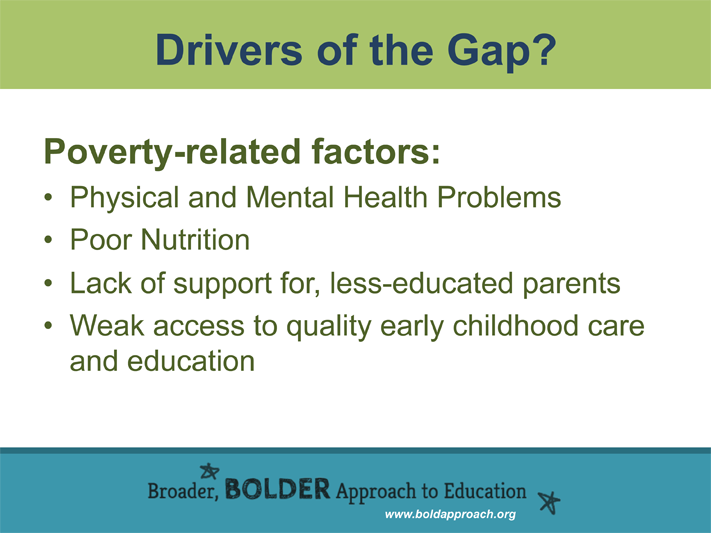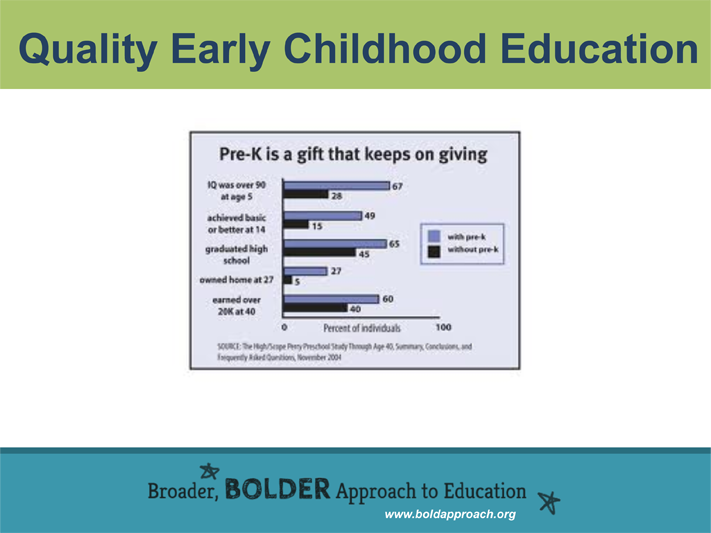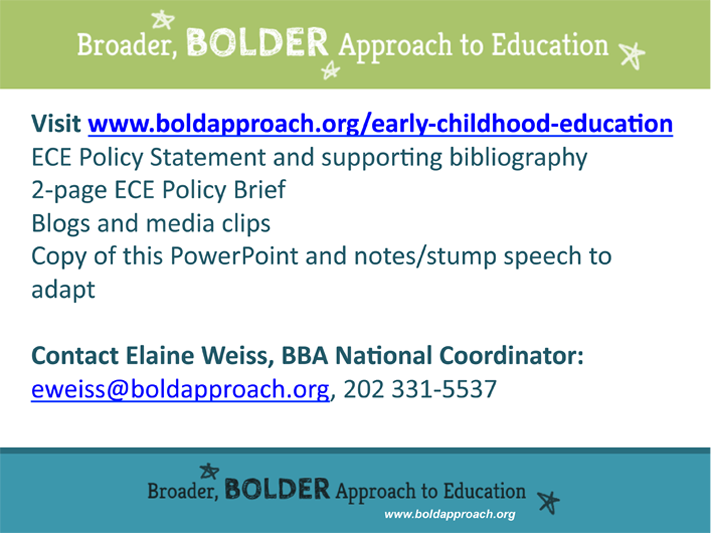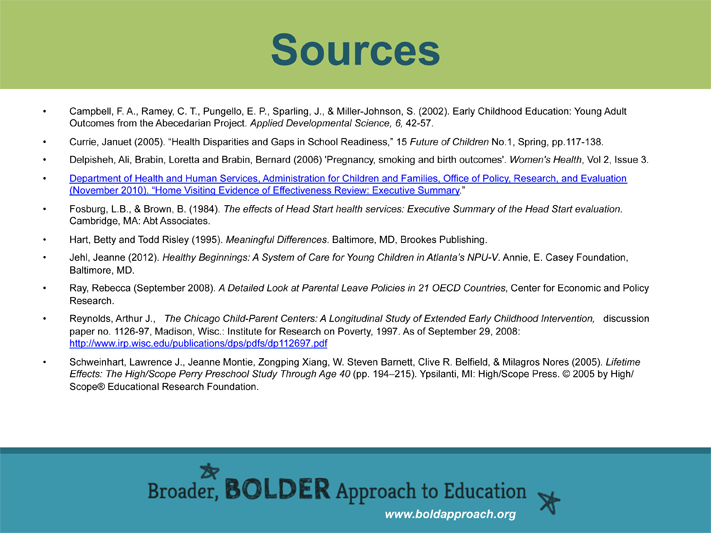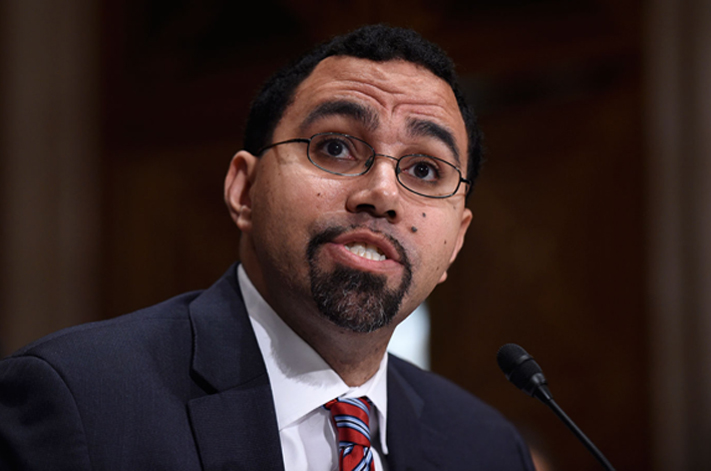Project Description
Opportunity and achievement gaps emerge long before US children enter kindergarten. Income-based differences in verbal interactions, health and nutrition, and the quality of paid care all affect young children’s development. The Broader Bolder Approach to Education promotes public investment in high-quality birth-to-8 policies that can narrow these gaps and boost low-income children’s achievement.
(click on graphics to enlarge)

Slide One
This presentation provides information, statistics, and arguments in favor of a broad set of early childhood care and education policies, including:
- Parental leave
- Nurse and other professional home visits for pregnant women and new parents
- Quality physical, mental, and dental health for pregnant women, young parents, and children
- Quality child care and pre-k that is accessible to and convenient for low-income families
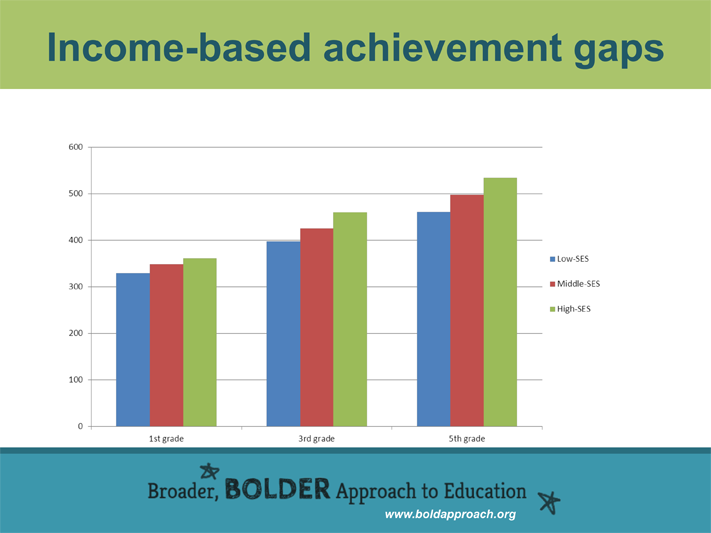
Slide Two
Many education reforms are focused on closing, or narrowing, achievement gaps that exist across income groups and races.
- By 5th grade, for example there is often a gap of 1-year (or more) between high- and low-income with respect to test scores/reading and math skills.
- As this graph shows, however, most of that gap existed by third grade, and fully half of it in first grade.
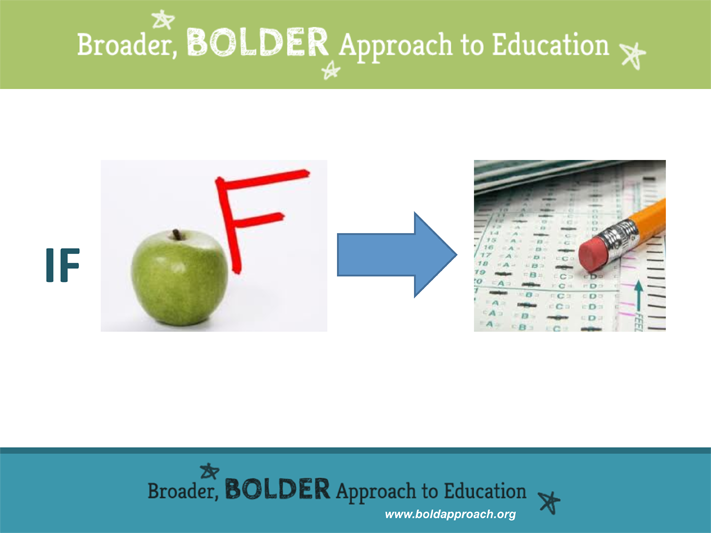
Slide Three
The policy response to this stubborn achievement gap has become setting universal standards, testing students to make sure they attain those standards, and rewarding or punishing their teachers (and schools) based on test results.
- This testing-and-accountability set of policies is the basis for federal No Child Left Behind, Race to the Top legislation and many state education policies.
- It has now been in place for well over a decade, but has produced very little progress in narrowing race- and income-based achievement gaps.

Slide Four
A major reason for the failure of these “reforms” is that they fail to recognize the root of the problem; low-income students arrive at kindergarten a year or more behind their better-off peers.
- As we saw from the data above, the gap starts far too early to be largely the fault of schools, even elementary schools. Half of the fifth grade gap is evident by first grade!
- Schools, in other words, are not largely creating the problem, but rather maintaining (sustaining) an inequitable starting point/status quo.
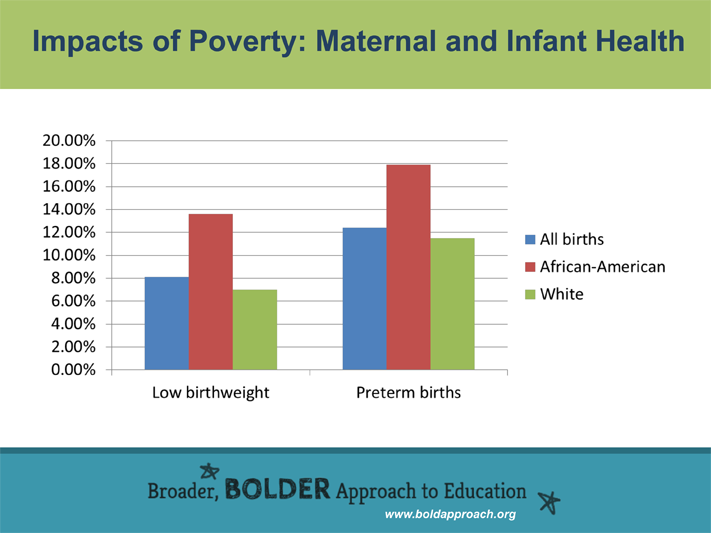
Slide Six
Parents who lack a range of resources also bring other risks to their infants and toddlers, especially with respect to health.
Mothers who smoke during pregnancy and who lack access to effective smoking cessation counseling and programs substantially increase the risk that their babies will be born premature and/or at low birthweight.
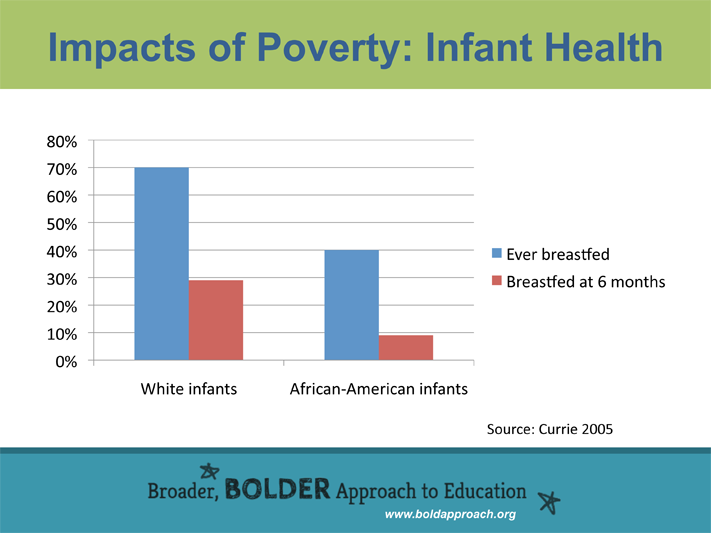
Slide Seven
Health differences in infancy: breastfeeding
Breastfeeding has been shown to improve infant health through three pathways: stronger immune systems, nutrients absent in most (cheap) formulas, and mother-baby bonding
- “The American Academy of Pediatrics recommends that infants be breast fed exclusively for their first six months and that cow’s milk not be introduced until after the first birthday. Some 70 percent of white infants, but only 40 percent of black infants, have ever been breast fed. At six months, 29 percent of white infants, but only 9 percent of black infants, are still being breast fed.” (source: Currie, p.127)
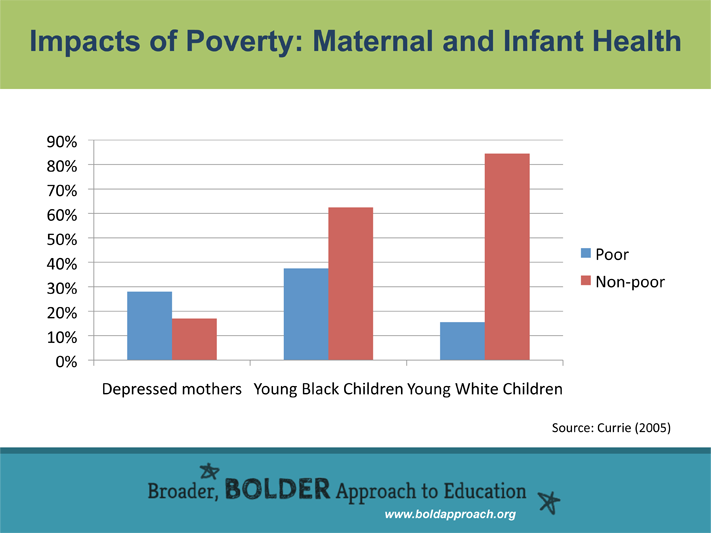
Slide Eight
Maternal depression impedes parent-child bonds; depressed mothers have less energy and patience, poorer communication and discipline skills, and weak parenting skills overall.
- “Evidence abounds that poverty is associated with a higher risk of depression. The poor are 2.3 times more likely to be depressed than the non-poor, adjusting for age, gender, ethnicity, and prior history of depression. This higher risk may be due both to heightened stress and to a lack of resources to cope with that stress. The incidence of pregnancy and postpartum depression in a sample of poor, inner-city women is about one-quarter, double the rate typically found among middleclass women. In the Infant Health and Development Study, 28 percent of poor mothers, as against 17 percent of nonpoor mothers, were depressed.”
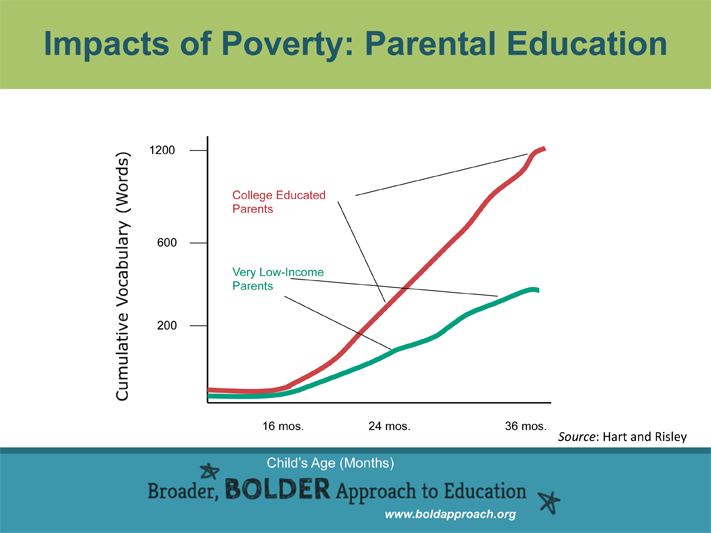
Slide Nine
Poor parental education – lack of preparedness for kindergarten
A seminal 1995 study found that differences in development appear very early.
- Two researchers, Betty Hart and Todd Risley, observed, taped, and assessed child-parent interactions among professional, working class, and very poor parents to understand the influence of those interactions on vocabulary development.
- Parents played with and spoke to their children very differently depending on social class, and differences in vocabulary growth between children in low socio-economic households and high socio-economic households begin to appear as early as 18 months. By three years of age, long before kindergarten, the best-off children had over twice the active vocabulary of their poorest peers.
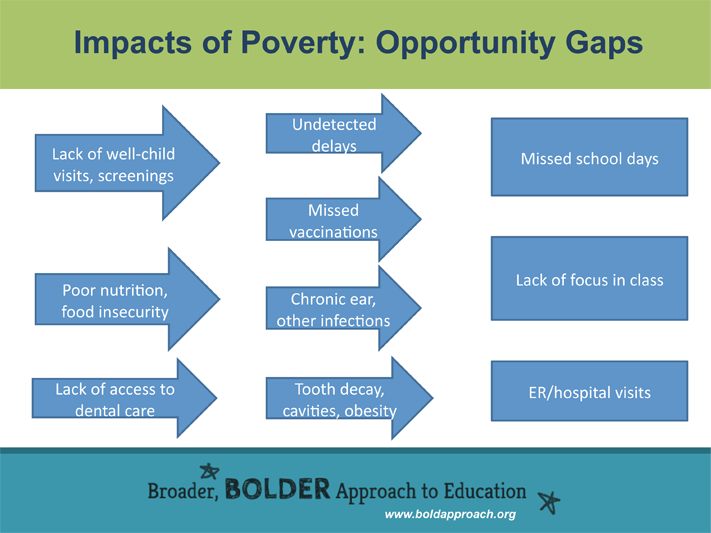
Slide Ten
Young children of parents who lack resources and access to comprehensive early health care also experience problems including:
- Lack of well-baby/child visits, vaccinations, early screenings and referrals
- Asthma can manifest very early (as young as 2-3 years) and, if not diagnosed, treated, and monitored, can impede children’s physical activities, focus, sleep, etc.
- Otitis media/hearing problems – ear infections are common among young children, but if recurring and/or chronic, are more problematic and can translate to long-term damage
- Poor nutrition –
- Iron deficiency, anemia, other nutritional problems → lack of energy and focus, etc.

Slide Eleven
How does this inform policy?
Given what we know about early childhood impacts of poverty and parental education and skill levels, policies must broaden the definition of “education” to start at birth and encompass family and community supports.
Broader, BOLDER definition of education includes improved K-12 policies, but emphasizes need for:
Quality early childhood education (paid and unpaid) – home visiting/parenting programs, early Head Start, Head Start, state pre-k
Health and nutrition supports – Expanded eligibility and access to WIC and SNAP as needed, access to mental, physical, and dental health care for all young children and their families, including through school-based health clinics

Slide Twelve
- Extensive research documents the critical importance of early parent-child bonds, and of parental leave in promoting such bonding, as well as helping parents adjust to having a new baby and to alleviating some of the stress of that transition.
- Yet, the United States is alone among Western nations in providing no mandated/government-supported paid maternity or other parental leave following the birth (or adoption) of a new child.
- On average, our European, Canadian, Australian, and Asian peers provide 3-4 months of leave that is mostly-to-fully paid (at usual salary), with some providing substantially more than that (Source: Rebecca Ray (September 2008)
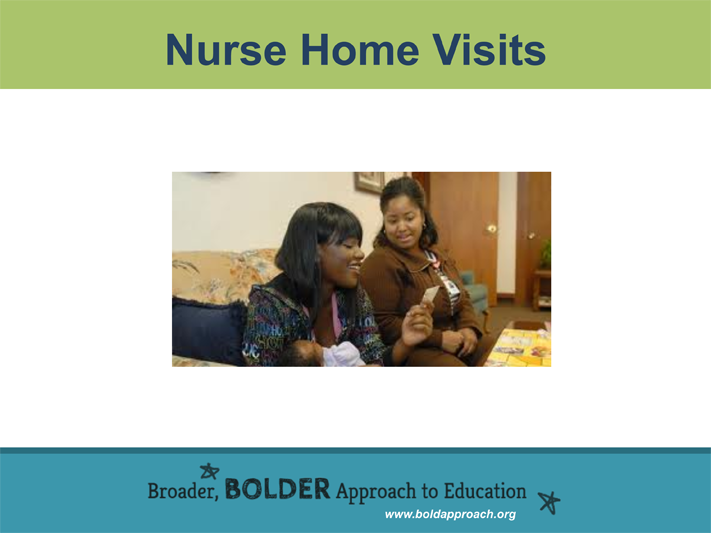
Slide Thirteen
Helping at-risk young parents/mothers AND their infants and toddlers get a better start provides a strong foundation. Home visits by nurses/other professionals during the mother’s pregnancy and through the baby’s first few years can great improve the life prospects of the whole family.
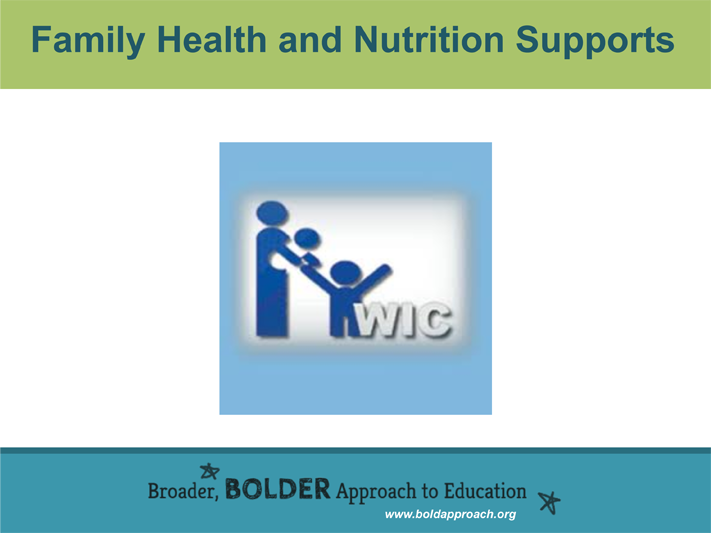
Slide Fourteen
Ensuring access to health care, rather than just eligibility for (or having) insurance is critical, as are enrollment in WIC and SNAP. In many low-income communities and households, helping families enroll in key support programs and coordinating connections to basic and follow-up health care are critical to making services available.

Slide Seventeen
A public-private partnership in Omaha, Nebraska (Douglas and Sarpy Counties) with a comprehensive approach to education begins with young new parents and at-risk babies and toddlers:
- The Network of Excellence is serving 546 children in private child care centers focused on improving quality.
- The Teen and Young Parent Collaborative has served nearly 900 individuals, including prenatal, teens, young adults, and children of teen parents.

Slide Eighteen
Full-service community schools in Vancouver Washington (and in Cincinnati, Ohio Evansville, Indiana, Portland, Oregon, Oklahoma City, and many others) provide ECE supports such as
- Providing quality early childhood education to better prepare at-risk children for school cognitively, emotionally, behaviorally, and socially
- Providing access to preventive and basic health care in the school setting in order to minimize lost days of school and lost productivity in the classroom
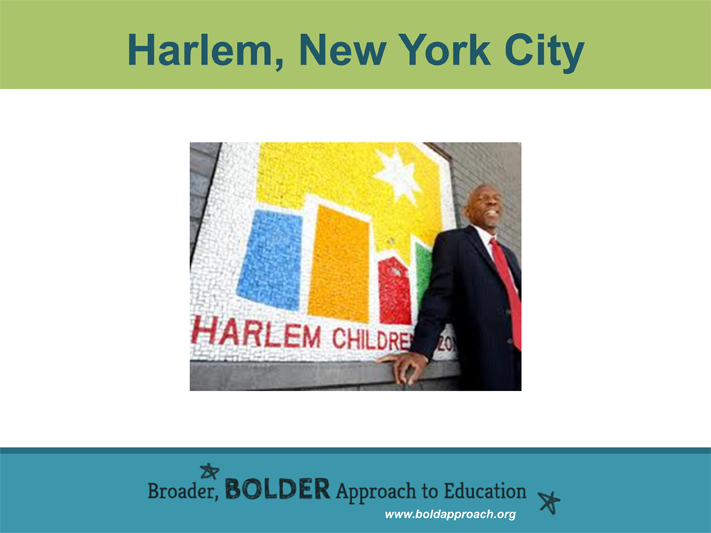
Slide Nineteen
The Harlem Children’s Zone Pipeline includes a range of services for at-risk parents and their children, including:
- Baby College® to teach young new parents of infants and toddlers about stimulating play, appropriate discipline, reading, etc.;
- Harlem Gems® high-quality early childhood education program;
- Community centers, including sites in public housing, to support family activities more broadly;
- Preventive foster care programs to keep at-risk families stable and intact;
- Asthma prevention and monitoring initiative
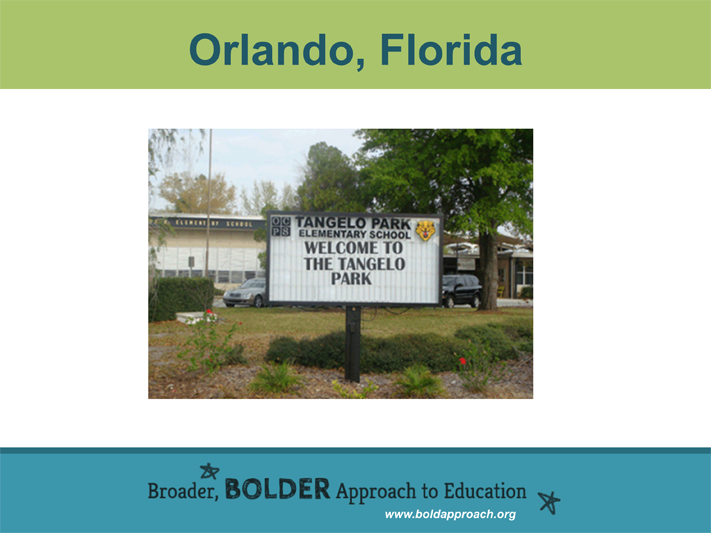
Slide Twenty
The Tangelo Park program in Orlando, Florida, has taken a comprehensive, community-wide birth-to-college approach to education for nearly 20 years, including:
- Full-day, year-round quality early childhood education, ages 2-5
- Nurses for early childhood and elementary education sites;
- Elementary school-based center for families with range of non-profit support services;
- On-site health services
